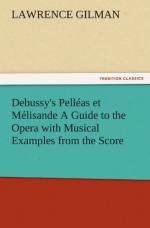He follows Wagner to the extent of using the inescapable device of representative themes, though he has, with his usual airy inconsistency, characterized the Wagnerian Leitmotiv system as “rather coarse.” It is true, however, that his typical phrases are employed far more sparingly and subtly than modern precedent would have led one to expect. They are seldom set in sharp and vividly dramatic contrast, as with Wagner; nor are they polyphonically deployed. Often they are mere sound-wraiths, intended to denote moods and nuances of emotion so impalpable and evanescent, so vague and interior, that it is more than a little difficult to mark their precise significance. Often they are mere fragments of themes, mere patches of harmonic color, evasive and intangible, designed almost wholly to translate phases of that psychic penumbra in which the characters and the action of the drama are enwrapped. They have a common kinship in their dim and muted loveliness, their grave reticence, the deep and immitigable sadness with which, even at their most rapturous, they are penetrated. This is a score rich in beauty and strangeness, yet the music has often a deceptive naivete, a naivete that is so extreme that it reveals itself, finally, as the quintessence of subtlety and reticence—in which respect, again, we are reminded of its perfect, its well-nigh uncanny, correspondence with the quality of Maeterlinck’s drama.
As it has been remarked, Debussy’s orchestra is here, with few exceptions, the orchestra of Mozart’s day. On page after page he writes for strings alone, or for strings with wood-wind and horns. He uses the full modern orchestra only upon the rarest occasions, and then more often for color than for volume. He has an especial affection for the strings, particularly in the lower registers; and he is exceedingly fond of subdividing and muting them. It is rare to find him using the wood-wind choir alone, or the wood and brass without the strings. His orchestra contains the usual modern equipment—3 flutes, 2 oboes, 2 clarinets, an English horn, 3 bassoons, 4 horns, 3 trumpets, 3 trombones, bass tuba, kettledrums, glockenspiel, cymbals, 2 harps, and strings; yet one may count on but little more than the fingers of both hands the pages in which this apparatus is employed in its full strength. And in spite of this curious and unpopular reticence, we listen here, as M. Bruneau has observed, to “a magic orchestra”—an orchestra of indescribable richness, delicacy, and suppleness—an orchestra that melts and shimmers with opalescent hues—an orchestra that has substance without density, sonority without blatancy, refinement without thinness.




